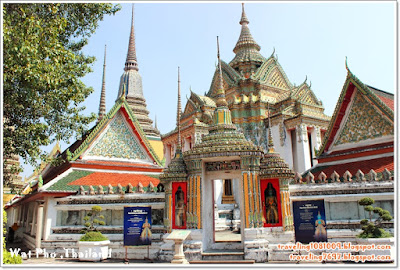Thai | English
The monastery is located in an area of 20 acres to the south of the Grand Palace, with Thai Wang road in the north, Sanam Chai road in the east, Setthakan road in the south and Maharat road in the west. Separated by a tall white wall on Chetuphon road, the monastery has two main quarters: the sacred or a chapel section, Buddhavas, and the residential or the monk's living section, Sangghavas.
It is said in a stone inscription that, after moving to the Grand Palace, King Phra Buddha Yod Fa The Great (King Rama I) recognized that there were 2 old temples along both sides of the Grand Palace: Wat Salak (Wat Mahatart) in the north, and Wat Phodharam in the south. He ordered his noblemen from the department of the Ten Crafts to restore Wat Phodharam in 1788. This first restoration took 7 years 5 months and 28 days. Then there was a celebration in 1801 and the Royal named it “Wat Phra Chetuphon Vimolmangklavas”, which was changed to “Wat Phra Chetuphon Vimolmangklararm” during the reign of King Rama IV. ( Ref.: www.watpho.com )
2 Sanamchai Road, Grand Palace Subdistrict, Pranakorn District, Bangkok 10200
(Date taken : January 15,2015 and April 2,2016)
Wat Pho directory
Entrance 2 (Chetuphon Road)
Khao Mor and Hermit Statues ( No.5)
Phra Maha Chedi Si Rajakarn ( No.2)
Phra Maha Chedi Si Rajakarn, a group of four huge pagodas surrounded by white wall with Thai-Chinese style sheltered gates decorated with colour-glazed tiles and Chinese rockeries guardians.
Each pagoda is 42-metre high, twelve or added notched-rim structures ending in a tall spire and elaborated with colourful mosaics. The one with green tile mosaic named Phra Maha Chedi Sri Sanpetdayarn (No.1), constructed during the reign of King Rama I to cover the ruined image of Buddha ‘Phra Srisanpetch' where relics of Lord Buddha are kept, represents the reign of King Rama I. The ruined standing Buddha is 16-metre high and was brought from the Royal Palace in Ayudhya.Phra Maha Chedi Dilok Dhammakaroknitarn (No.2), the one with white-tile mosaic representing the reign of King Rama II, was built by his son, King Rama III.
He also built the yellow tile mosaic pagoda, Phra Maha Chedi Muni Batborikharn (No.3), for his own reign and for the praise of Buddha. The last one, in dark blue tile mosaic, represents the reign of King Rama IV or King Mongkut. It was built in the same style as Phra Maha Chedi Song Phra Srisuriyothai (No.4) of the Ayudhya period with the purpose of praise for the Lord Buddha.
( Ref.: www.watpho.com )
Phra Maha Chedi Sri Sanpetdayarn (No.1)
Phra Maha Chedi Dilok Dhammakaroknitarn (No.2)
Phra Maha Chedi Muni Batborikharn (No.3)
Phra Maha Chedi Song Phra Srisuriyothai (No.4)
Phra Buddha Saiyas ( No.4)
Phra Mondop ( No.3)
Wat Pho Giant ( No.6)
Phra Ubosot ( No.1)
This is one place you should not miss to visit ,enjoy.


























ไม่มีความคิดเห็น:
แสดงความคิดเห็น